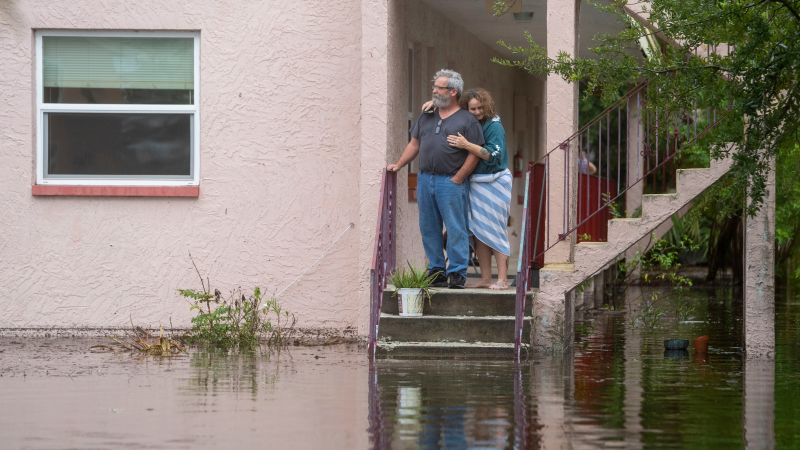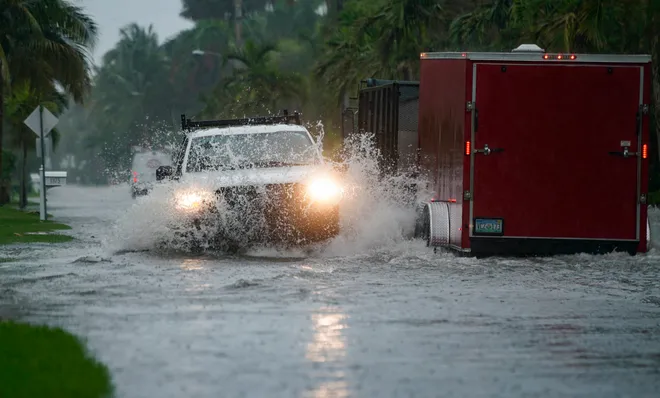Hurricane Idalia's dangers explained: Will forecasters' worst fears materialize?
Hurricane Idalia made landfall Wednesday as one of the more powerful storms in Florida's history, reaching some of the worst case scenarios emergency officials have feared for years but avoiding others.
Idalia was forecast to be a Category 4 storm at landfall, arriving on a full moon when tides are naturally higher and at one of the most dangerous angles to the coast.
Although briefly reaching a Category 4 status as it approached the Florida coast, Idalia's winds dropped to 125 mph, making it a Category 3 hurricane at landfall along the Big Bend.
The hurricane center had forecast Idalia to continue strengthening before landfall, however its barometric pressure rose quickly Wednesday morning – from 940 millibars at 6 a.m. to 949 millibars at landfall at 7:45 a.m. The lower the pressure at the center of a storm, the more destructive, so the change likely lessened the damage expected to occur from Idalia's destructive winds.
Idalia text message updates:Sign up to receive text updates on Hurricane Idalia and its aftermath

Timing of tides crucial as Idalia makes landfall
The National Hurricane Center had warned the storm surge could be higher than many single-story buildings, reaching up to 16 feet in the vulnerable Big Bend region if it arrived at high tide. And Idalia's landfall coincided with the full moon happening Wednesday night, so tides were already higher than normal.
The moon's gravitational pull on the Earth's high and low tides is strongest during full and new moons. So storm surge, which piles water on top of the tide, reaches higher levels if it arrives during a full moon.
As a hurricane approaches the coast, water that has been piled up in the center flows outward toward the shore and is blocked by the upward slope of the ocean floor. The surge is when that water level is suddenly forced upward and flows over land and into rivers. A sloping continental shelf along the Gulf of Mexico makes the coastline more vulnerable than the nation's Atlantic coast where steep slopes and a narrower continental shelf allow lower surge levels. And the angle of the Big Ben exacerbates that effect.
Ultimately however, Idalia's landfall occurred closer to low tide, so the flooding is not likely to meet the worst-case scenarios.
Even so, it was apparent by first light that the damage was devastating in many areas — just not as bad as it would have been if the surge pushed ashore when tides were highest. Major flooding occurred in locations along the coast and high water records were broken.
In Cedar Key, the National Weather Service reported a peak surge of 6.79 feet at the gauge, a new record, but lower than forecast if the storm surge arrived at high tide. The previous record – 6.1 feet – was set during Hurricane Hermine in 2016. It wasn't immediately clear how the peak water will compare to the surge forecast. It sometimes takes weather experts weeks to determine the height of the storm surge.
In Steinhatchee, closer to the point of landfall, the tide gauge peaked at 8.03 above the high water mark for the station, almost a foot above the previous record, also set during Hermine.
The next high tides near where the storm came ashore are on Wednesday afternoon.
Flooding is possible all along Idalia's path, with the National Weather Service warning of storm surge along Florida's northeast coast and through the Carolinas.

Why is the northeast Gulf Coast so vulnerable?
The contours of the Gulf of Mexico offshore in the Big Bend region, make it one of the most vulnerable locations to storm surge in the United States, wrote Jeff Masters and Bob Henson with Yale Climate Connections earlier this week. The wide continental shelf with shallow waters offshore allows water being pushed ahead of a hurricane to stack up, the pair wrote.
When Hurricane Dennis, a Category 5 storm, made landfall 150 miles to the west in 2005, the hurricane center reported it trapped a "shelf wave" of higher surge between it and the coast, pushing record high water levels into St. Marks, devastating the small community on the coast and destroying buildings that were never rebuilt.
During Hurricane Hermine, a Category 1 storm, the Gulf surged over seven feet above ground level in the region, Masters and Henson wrote.
Flooding in Charleston, South Carolina on Tuesday night was just a few inches below record flood levels, the weather service said, with much higher tides expected as Idalia arrives. Charleston was feeling the influence of the arriving full moon, as well as the offshore presence of Hurricane Franklin, said meteorologist Steven Taylor.
Storm surge fears in Tampa Bay area
For years, forecasters had feared a massive storm surge pushing into the heavily populated and vulnerable Tampa Bay area, preparing for the worst as Hurricane Ian approached last year. However, with Ian making landfall to the south, water levels dropped in Tampa Bay as Ian arrived.
The area was not as fortunate on Wednesday morning. Water levels jumped nearly five feet higher than yesterday's high tide at a gauge on Tampa Bay in St. Petersburg. Water was pushing into some of the creeks and streams around the bay, which have risen 2-3 feet.
On the Alafia River at Riverview, the surge broke a record set during Hurricane Frances in September 2004 by about 4 inches.
A spotter reported to the weather service that homes were flooding in Port Manatee, Florida.
Record flooding is forecast along the Alafia River, which flows into Tampa Bay, the weather service reported. At 6 a.m. the river level was more than 1.5 feet above flood level and expected to rise several inches above the record flood level set in 2004.
Disclaimer: The copyright of this article belongs to the original author. Reposting this article is solely for the purpose of information dissemination and does not constitute any investment advice. If there is any infringement, please contact us immediately. We will make corrections or deletions as necessary. Thank you.





